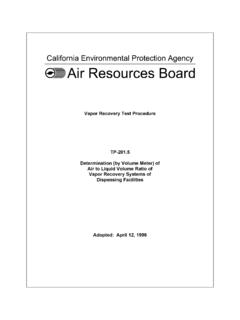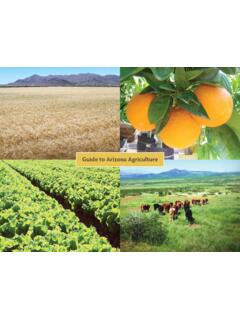Transcription of SAN DIEGO COUNTY AIR POLLUTION CONTROL DISTRICT
1 SAN DIEGO COUNTY AIR POLLUTION CONTROL DISTRICT TEST PROCEDURE TP-96-1 THIRD REVISION-3/1/96 STATIC PRESSURE LEAK TEST PROCEDURE VOLITILE FUEL VAPOR RECOVERY INSTALLATIONS EXCEPT ASPIRATOR ASSIST SYSTEMS APPLICABILITY This procedure applies to gasoline dispensing facilities that recover vapors from storage tank fill and vehicle fueling operations (Phase I and II vapor recovery), except for aspirator assist systems that are tested according to TP-96-4. The objective is to determine compliance with DISTRICT Rules , , and ; Chapter 3, Article 5 of the State of California Health & Safety Code (H and Section 94006, Title 17, California Code of Regulations (CCR). ARB Certification Rule and State law require that all vapor recovery systems be State of California Air Resource Board (ARB) certified. To be ARB certified, all bulk storage tanks must be connected to the Phase II vapor recovery system in the configuration shown in the applicable ARB Executive Order.)
2 Except in special cases involving incineration, vapors must return to the tanks from which fuel was pumped in order for the system to be a certified system as required by State law. A provision of this procedure is used to check vapor manifolds to ensure the underground plumbing complies with the applicable ARB Executive Order. System Effectiveness Rule and various ARB Executive Orders require that Phase I and Phase II vapor recovery systems perform with the same effectiveness as the State Air Resources Board (ARB) certification test systems associated with the applicable state Executive Orders defining the systems. The certified systems and components either passed an ARB ten-inch water column gauge (wcg) test, a five-inch wcg test or a two-inch wcg test. Systems passing this procedure are at least the same as the certification test sites with regard to vapor leakage. This procedure is also used to identify equipment defects prohibited by Rule and Section 94006 of the CCR.
3 Also, liquid blockage occurs in bootless nozzle vacuum assist systems where leaks into the vapor line break or reduce the vacuum needed to clear the vapor return passage of liquid. This procedure is designed to identify those vacuum assist leaks. Although air to liquid (A/L) or vapor to liquid (V/L) tests may indicate a problem, those tests can not be used to identify the cause such as a faulty pump, piping leak, nozzle leak, etc. Those tests may not indicated an existing problem if the hoses are drained of ingested liquid prior to the test. Nozzle Shutoff Rule and State law require that balance system vapor recovery nozzle back-pressure shutoff mechanisms not malfunction in order to minimize spillage. This procedure is used to check balance system nozzle shutoff mechanisms to ensure they activate between 6 and 8 inches wcg. 95% Vapor Recovery Rule requires 95% vapor recovery during the truck delivery of fuel to bulk storage tanks (Phase I vapor CONTROL ).
4 Air aspirated into the fuel during Phase I deliveries prevents compliance. Significant vapor leakage from adjacent tanks with a vapor manifold to the tank receiving fuel would also preclude compliance. This will not happen if the system passes this procedure. BIASES AND INTERFERENCES The allowable leak rate, originally developed by California State Fire Marshal, is gallons/minute or about .066 ft3 / min. (cfm) at an average system pressure of inches wcg. The State Fire Marshal wanted to ensure that any leaks at ground level at operating pressures would dissipate before becoming a fire hazard. Later it was found that this rate ensured that vapor transfer efficiencies from bulk deliveries would not be changed by more than 1%, on the average, if the Fire Marshal s standard was adopted. However, the leak rate is based on the assumption of no vapor expansion during the test. That assumption is not valid under most weather conditions.
5 This procedure was designed to minimize bias under the conditions in which the test is most likely to be conducted. Most static pressure tests are run in the morning or early afternoon. That is usually when barometric pressure is decreasing and when direct sun on exposed metal vent pipes, metal manhole covers and concrete driveways creates thermal convection in storage tanks that brings unsaturated air into contact with the liquid surface and causes vapor growth. Besides weather, accuracy can also be affected by the last bulk delivery, especially within five hours of that delivery. Because of factors outside the test, all static pressure leak tests are imprecise screening tests under most field conditions. To accurately determine gas-tightness, other methods, such as the use of soap solutions, helium detection, sonic detectors, etc., must also be used. Explosimeters (gas detectors) may be used except where lines are filled with nitrogen.
6 This procedure requires the addition of other methods of detection, where appropriate, to ensure compliance with local and state requirements. The most serious factor biasing the results is vapor growth due to evaporation and barometric pressure changes. When the rate of growth equals or exceeds the rate of flow out of a leak or leaks, the leaks are undetectable using a static pressure test. This is called masking . Even when the flow out of the leak exceeds the rate of vapor growth, the growth rate changes the slope of the pressure decay curve. A system that would fail on a windless, foggy morning with constant barometric pressure might pass on a hot day. When sufficient amount of cold nitrogen is introduced into the vent pipes it counter acts convective movement and temporarily stops or significantly reduces evaporation so that the accuracy of the static pressure test significantly improves.
7 This usually works if the ullage is large enough and nitrogen doesn t come in contact with the liquid surface. However, direct radiation from the sun on the system on a day exceeding 100 F will create a bias that renders any pressure decay curve unusable, regardless of ullage. Under such conditions, other methods must be used to determine leak tightness. For underground tanks, factors outside the test, such as evaporation and barometric changes, preclude the test from being any more accurate than + inches wcg, except under unusually favorable conditions. Because the accuracy is not better than + inches wcg most of the time, it is necessary to have a five-minute, ten-minute and fifteen-minute test depending on the tank ullage in gallons. (See Table 1 and Figures 2, 3, and 4 at the back of the procedure). For above ground tanks, static pressure tests can not be used alone to determine system leakage under most summer time conditions, even when the tanks are insulated.
8 Solar radiation has a much greater impact on aboveground tanks than it does on underground tanks. The tanks are frequently square which enhances evaporation due to convection. During the summer, it is often not possible to conduct a meaningful static pressure test where the results are based soley on a rate of pressure decay. Therefore, the emphasizes is on demonstrating compliance by passing a soap solution test of all exposed piping and fittings where the system pressure does not decay more than - inch over a fifteen minute period. Because this procedure is used to determine the probability of rule compliance, there are different standards for vacuum assist systems without processors, for balance systems, for vacuum assist systems with processor, and for above ground tanks. There is also a manifolded tie test that is part of this procedure which has no known bias.
9 When determining actual emission rates or system efficiencies for purposes such as emissions inventory, health risk assessments, etc., there is no allowable, unquantifiable leakage. A static pressure test is a screening device. It is not a reliable method to determine if a system is free of leaks. Therefore, additional methods are specified when actual system emission rates are needed. No decay due to leakage is allowed. For this portion of the procedure, there is no known bias because the system either has detectable leaks or it doesn t. PREREQUISITES TO TESTING The following requirements must be met before a valid test may be performed: The DISTRICT Must Be Notified The appropriate person specified in the Air POLLUTION CONTROL DISTRICT Authority to Construct letter must be contacted within ten working days of completion of construction to establish a mutually agreeable test date.
10 Normally, the tests will be witnessed by a DISTRICT representative; however, the DISTRICT engineer may, under certain circumstances, authorize testing without a DISTRICT observer being present. If the DISTRICT is not notified of testing in advance, then this test or other required tests may be declared invalid. If found invalid, testing may have to be repeated with a DISTRICT observer present. Minimum Tank Ullage The ullage (vapor space) in each tank being tested must be at least 15% of the tank s capacity, but in no case less than 300 gallons per tank for tanks under 1000 gallons capacity. If the tanks are manifolded, each tank must meet this minimum ullage requirement. This minimum is design to avoid reactions of the nitrogen with the liquid fuel surface that will cause vapor growth. Maximum Tank Ullage The combined maximum ullage space of the tank(s) depends on whether a five-minute, ten-minute or fifteen-minute test is conducted.

